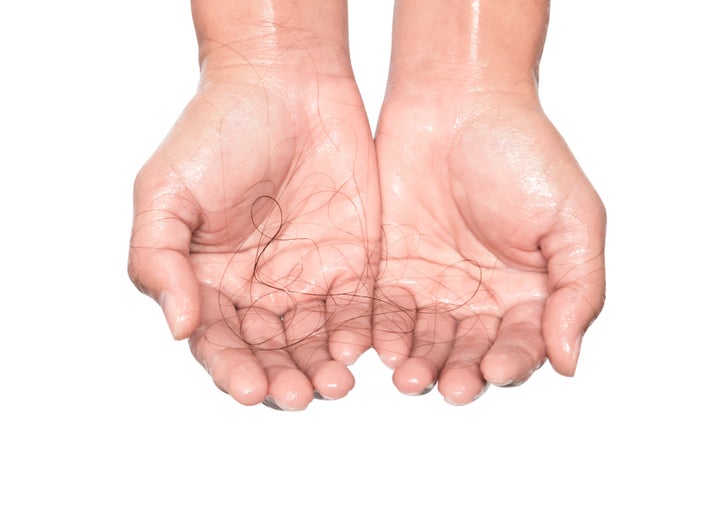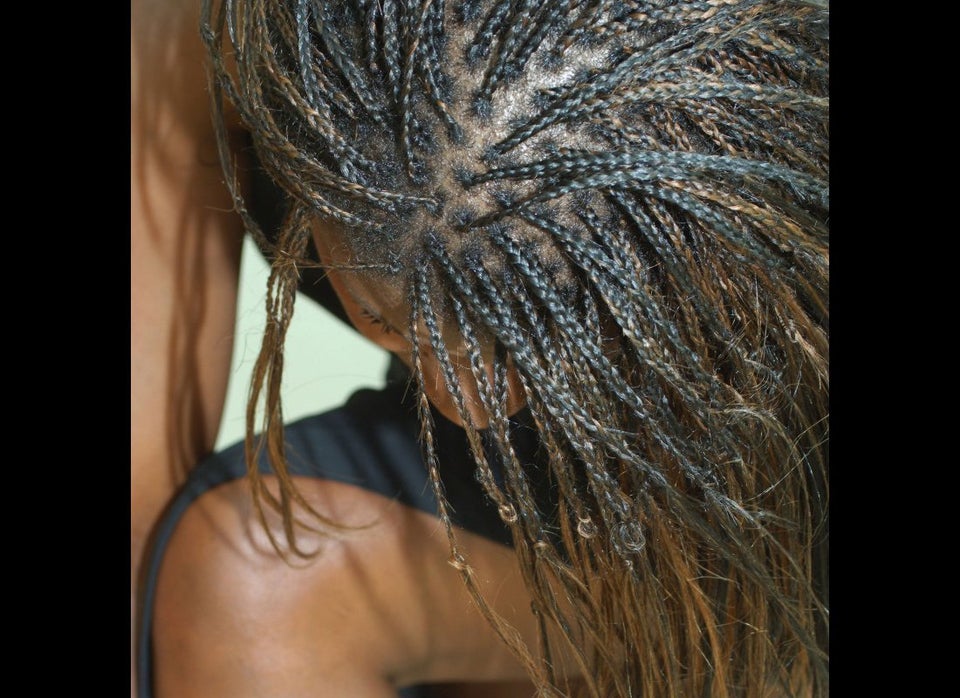Hair often plays a critical role in forming a woman’s identity, so it should come as no surprise that female hair loss can have a major effect on self esteem, mood and confidence. It can even result in increased stress, anxiety and clinical depression, according to board certified dermatologist Anna Drosou of DermSurgery Associates in Houston, Texas.
Discussion around female hair loss pales in comparison to talk about male baldness, so we spoke with several experts who explained to us the most common causes of female hair loss and how to treat them.
As always, consult with your doctor before diagnosing yourself with any of the following causes or conditions.
First, Get To Understand Your Hair Cycle
Everyone’s healthy hair cycle follows a similar pattern: The active growth phase of hair (anagen) lasts 3-5 years, followed by a 10-day transitional period (catagen), and finally the telogen phase, in which the hair sheds and follicles fall out. The follicle is then inactive for three months before the whole cycle is repeated.
Some people experience hair loss at a pace that’s more rapid than usual (telogen effluvium), which is a prolonged (and usually sudden) period of hair loss. “Telogen effluvium is a reactive type of hair loss, caused by some sort of internal disruption, i.e. nutritional inadequacies, illness, surgery or hypo/hyperthyroid,” Anabel Kingsley, a trichologist, associate member of The Institute of Trichologists and brand president at Philip Kingsley, told HuffPost.

Hair loss, thinning and similar issues occur when the normal hair cycle is disrupted, Kingsley explained. This can be due to a variety of reasons, some common for both women and men, others focused specifically on women. The American Academy of Dermatology defines normal hair loss as 50 to 100 strands a day, so anything more than your usual amount could be reason to see a doctor.
Drosou said that hair loss due to hormones, stress, iron and diet-related causes is generally reversible. It’s harder to reverse hair loss connected with hereditary causes or rare inflammatory cases. Upon first seeing a patient, Kingsley first conducts blood tests to look at potential hormonal or nutritional deficiencies.
Hormones
Hormones can wreak havoc on our skin, and unfortunately that applies to our hair, too.
A balance of estrogen, progesterone and testosterone is necessary for healthy hair growth, according to Roy Stoller, a board certified surgeon and founder of Hair Transplant NYC.
“Although estrogen usually promotes hair growth, when in excess, it can tip the balance and actually increase testosterone, causing a testosterone-related hair loss,” Stoller told to HuffPost. In that case, there may be a genetic predisposition to dihydrotestosterone (DHT), which attacks the hair follicle, diminishing and eventually resulting in total loss of the follicle.
Stoller provides a solution to this situation to block the conversion of testosterone to DHT and prolong the life of the hair follicle: “The one most prescribed drug is Finasteride. Although only approved for men, women have also had success with it.” This is a prescription-only drug, so speak to your doctor if you think it might be a good fit and ensure you know all the contra-indications, which include loss of libido among others.
Pregnancy Hormones
It’s not uncommon for a pregnant woman to receive compliments on her hair, which appears fuller, shinier and overall more healthy during pregnancy. Though not every woman experiences this, for those who do it’s due to a prolonged anagen phase thanks to higher estrogen and progesterone hormones during pregnancy.
However, Stoller noted that 40% of women will experience excessive shedding (telogen effluvium) post-birth. “This is due to the physical stress of the labor, and it’s self-resolving without treatment,” Drosou said. Stoller added the effects are temporary, lasting around three to four months, and starting at three months post-birth. Being diligent with the intake of all necessary vitamins and minerals is helpful in dealing with this type of hair loss, and it’s completely reversible.
Menopause Hormones
Both before and during menopause, hormonal changes affect hair growth, particularly due to a decrease in estrogen and progesterone. Stoller said that female pattern hair loss is more common during that period, and could even relate to hair loss from androgens (male hormones) depending on the woman’s genetics. “The decrease in the female hormones leave the hair cells unprotected from circulating androgens. Over time, the hair shafts will thin, miniaturize and eventually die,” Stoller said.
“Estrogens are ‘hair friendly’ and help to keep strands in their growth phase,” Kingsley explained. “They also offer a sort of buffer against androgens, which are not very good for your scalp hair. The extent to which a woman will experience changes to hair diameter is down to genes,” she added.
Studies have shown that Finasteride can be successful against hair loss in pre- and post-menopausal women who do not intend to be pregnant. There are suggestions that anti-androgen hormones can help, as well as iron supplements. Hormone Replacement Therapy (HRT) can be beneficial in hair loss too, by slowing it down or stopping it completely, studies show. Another topical treatment that is proven to work in menopausal women is Minoxidil.
Thyroid Irregularities
The thyroid gland is responsible for regulating our metabolism, and it’s usually the first thing a doctor will look at if you have issues with weight changes or hair loss.
Thyroid hormones are released in the body at a steady steam, Stoller said, regulating everything from breathing to temperature, body weight and hair growth. Nutrition and thyroid disease can affect the release of those hormones, and Drosou notes that low thyroid hormones, also known as hypothyroidism, can cause reversible alopecia and even lateral eyebrow thinning. With proper medication to support the thyroid, the hair loss can be completely reversed.
Anemia
Anemia, or iron deficiency, is one of the most common causes of hair loss in women, apart from hormones.
“Low iron stores can force hair into a chronic rest phase, resulting in increased shedding and reduced density,” Stoller said. Drosou adds that iron deficiency is quite common if you’ve experienced sudden weight loss, and is often the result of going on a vegan diet.
“Iron is used both for hair production and red blood cell production,” Drosou said. “The body wisely prioritizes the red blood cell production, so if it has a limited amount of iron intake, the first thing to be affected is the hair.” Speak to your doctor, who will be able to give you a suitable iron/ferritin supplement depending on your needs.
Eating Disorders
These affect the body in various ways, creating physical stress for the body and often resulting in hair loss.
Stoller notes that the protein in hair (keratin) is not essential for the body, and at periods of malnourishment, hair growth will stop. “The body prioritizes nutrients going to vital organs (brain, heart, lungs) over hair, so shedding occurs,” Stoller said. “Depending on a person’s age, genetic makeup and health status, regular hair growth usually returns in about six months after the malnourished state is resolved,” Stoller said.
Heredity
“The hereditary form of alopecia is female pattern hair loss, or androgenetic alopecia,” Drosou said. This is usually seen as diffused thinning, not bald spots.
She notes that this form of hair loss can happen at any point during adult life, and is more common in connection to menopause as it’s connected with androgen levels. Women with conditions like polycystic ovary syndrome, which is connected with androgen levels, could see hair thinning earlier.

“Medications that block androgens, like spironolactone, are somewhat effective at reducing hair loss and preventing worsening of the condition,” Drosou said.
Frontal Fibrosing Alopecia
This is a type of hair loss that leaves scars at the front of a woman’s hairline, and it’s becoming more common, particularly in post-menopausal women. Kingsley said it’s now seen even in younger women, but the exact triggers aren’t known.
“It is thought to be caused by a faulty immune response, whereby your body attacks and destroys hair follicles at the front of your hairline, leaving scar tissue behind,” Kingsley said. “Unfortunately, you cannot regrow hair from a scarring alopecia. However, at [hair] clinics we endeavor to stop it from progressing and reoccurring.”
This is not to be confused with traction alopecia, a type of hair loss that’s a result of wearing tight hairstyles, like ponytails or tight braids worn repeatedly that pull out the hair follicles. Kingsley said these hair styles should be avoided as they can cause traction breakage, which could pull out hairs from the follicle and then lead to traction alopecia over time. If treated early, the hair can grow back normally after six months. Otherwise, it could cause non-reversible scarring alopecia, which is often seen in women who use weaves, hair extensions, braids and chemical relaxation.
Insulin Imbalance
Insulin is a hormone that regulates energy. It’s obtained from the food we eat, and then released into the body to help store energy for future use. Since insulin can affect hair growth, it’s important to take note of the glycemic index (GI) ― a ranking of how foods affect your blood glucose levels ― of foods you eat.
“Eating high-glycemic foods in excess, often in combination with a sedentary lifestyle, can cause an overload of insulin in the body,” Stoller said. “Too much insulin disrupts ovulation and signals the ovaries to make more testosterone,” Stoller said. A change in diet and lifestyle can help insulin levels and restore hair growth.
Stress
We know stress can be catastrophic for the body and the mind, so it’s no surprise that stress plays a major role when it comes to hair loss.
Kingsley notes that anything that affects your physical well-being impacts your hair to an even greater degree. “Hair is non-essential to physical survival and so it will always be the first part of you to suffer when something is off-kilter,” he said.
Stress is connected to our cortisol levels, which are increased, Stoller said, when insulin levels rise, in turn triggering a testosterone increase. After a particularly stressful event, and 2-4 months after the event, women may experience hair loss, but after 6-plus months hair returns to normal, Stoller added.
Drosou notes that stress-related hair loss is also seen after events like childbirth, hospitalization, divorce and the death of a significant other. The reason is that “stress induces a larger percentage of follicles to enter the telogen phase, resulting in increased shedding of hair. The hair follicles remain intact, so complete recovery is expected after 6-12 months,” Drosou said.
The Takeaway
No matter what the underlying cause of hair loss might be, as with many health issues, a balanced diet with the necessary nutrients and vitamins is essential.
Hair is the first point of damage when something is out of balance in our bodies, as it’s a “non-essential” tissue or a vital organ. But as hair cells are the second-fastest growing cells our body makes (the fastest-growing are the cells lining the gastrointestinal tract), their nutritional requirements are high, Kingsley said. Supplements can be helpful in the support of good hair health, in conjunction with a healthy balanced diet. Looking after the scalp and cleaning it properly is also important to support healthy hair growth, as well.
As soon as you notice an increase in hair loss, it’s important to take action and see a dermatologist, trichologist or specialist. Every situation is very different, so seeing an expert is essential.
